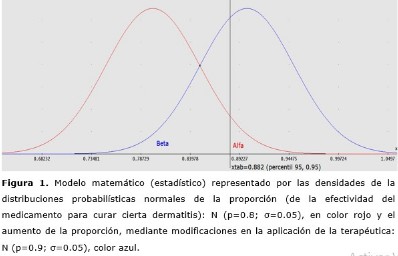Alternativa didáctica para estimular el pensamiento creativo de los profesores y estudiantes
Palabras clave:
INFERENCIA ESTADÍSTICA, PENSAMIENTO CREATIVO, APRENDIZAJEResumen
Fundamento: actualizar de forma constante los métodos, procedimientos y vías para resolver problemas, cuyas soluciones constituyen estereotipos de la estadística inferencial, los cuales no estimulan el pensamiento creador de profesores y estudiantes.
Objetivo: ilustrar a través de la resolución de problemas de la estadística inferencial como estimular el pensamiento creador de los profesores de Bioestadística y los estudiantes de la carrera de Medicina.
Métodos: se emplean los métodos teóricos: análisis-síntesis, inducción-deducción y abstracción-concreción. Construcción de curvas de la distribución normal, procesos de comprensión, explicación e interpretación. Se aplican métodos, procedimientos y algoritmos matemáticos y estadísticos.
Resultados: se elabora una alternativa didáctica para estimular el pensamiento creativo de los profesores y estudiantes de la carrera de Medicina, la cual ilustra la importancia del tema: Introducción a la inferencia estadística. Se integran y se sistematizan conceptos de variable aleatoria, distribución normal, probabilidad, dominio de aceptación, dominio de rechazo, estimaciones puntuales, entre otras.
Conclusiones: mediante situaciones de salud a enfrentar por el Médico General en su quehacer profesional, en las cuales se evidencien las necesidades de interpretar los errores de primero y segundo género: α y β. Se consolidan los conocimientos y habilidades relacionadas con los conceptos abordados en el tema: introducción a la estadística inferencial, mediante programas informáticos profesionales se visualizan los resultados alcanzados, según la modelación y la simulación matemática.
DeCS: CREATIVIDAD; ESTUDIANTES DE MEDICINA; DOCENTES; ESTADÍSTICAS DE SALUD; MATERIALES DE ENSEÑANZA.
Descargas
Citas
1. MINSAP. Perfeccionamiento del plan de estudio D de la Carrera de Medicina. La Habana: MINSAP; 2016.
2. Centro de Cibernética Aplicada a la Medicina. Informática Médica: Bioestatística. T. II. La Habana: Ciencias Médicas; 2004.
3. De la Horra J. Estadística Aplicada [Internet]. Madrid, España: Editorial Díaz de Santos S.A; 2012 [citado 28 Mar 2018]. Disponible en: https://estadisticaunicaes.files.wordpress.com/2012/05/uned-estadc3adstica-aplicada-julic3a1n-de-la-horra.pdf
4. Efímov A, Korakulin P, Pospélov P, Teréschenko A, Vokólov E, Zemskov V, et al. Problemas de las Matemáticas Superiores. Moscú: Editorial Mir; 2014.
5. Koroliuk V. Manual de la teoría de probabilidades y estadística matemática. Moscú: Editorial Mir; 2016.
6. Fardales Macías V, Diéguez Batista R, Puga García A. Una aproximación a las concepciones que prevalecen en la formación estadística del profesional médico. MediSur [Internet]. 2014 [citado 16 Jun 2016];12(1):[aprox. 9 p.]. Disponible en:
http://www.medisur.sld.cu/index.php/medisur/article/view/2270/1439
7. Calero Hechavarría M, Rodríguez Corona O, Armas Pupo YR, Núñez Rojas Y. Propuesta de tareas docentes para fortalecer el proceso de enseñanza-aprendizaje de la Metodología de la Investigación. CCM [Internet]. 2013 [citado 16 Jun 2016];(1)Supl 1:[aprox. 11 p.]. Disponible en: http://www.revcocmed.sld.cu/index.php/cocmed/article/view/1265/306
8. Swift L, Miles S, Price GM, Shepstone L, Leinster SJ. Do doctors need statistics? Doctors´ use of and attitudes to probability and statistics. Stat Med. 2009;28(15):1969-81.
9. Tavares Paes A. Teaching statistics to physicians: a five-years experience. ICOTS 8. Brasil: Universidade Federal de São Paulo, Instituto Israelita de Ensino e Pesquisa Albert Einstein; 2010 [citado 16 Jun 2016]. Disponible en:
http://iase-web.org/documents/papers/icots8/ICOTS8_10F4_PAES.pdf
10. Herman A, Notzer N, Libman Z, Braunstein R, Steinberg DM. Author ́s Reply: Statistical education for medical students-Concepts are what remain when the details are forgotten. Stat Med. 2008;27(12):2267-72.
11. Numa M, Martín A, Diéguez R, Sánchez A. La formación estadística universitaria orientada a la solución de problemas profesionales. Pedag Univ [Internet]. 2014 [citado 22 Feb 2018];19(1):[aprox. 17 p.]. Disponible en: http://www.cvi.mes.edu/peduniv /index.php/pedu niv
12. Infante Y, Bayés E. Propuesta de un folleto de ejercicios de Bioestadística. Medisan [Internet]. 2016 [citado 2018 Sep 3];20(12):[aprox. 7 p.]. Disponible en: http://www.medisan.sld.cu/index.php/san/article/view/167
13. Zimmermann W, Cunningham S. Visualization in Teaching and Learning Mathematics. Washington: Mathematical Association of America Washington; 1991.
14. Olmedo Canchola VH, Ariza Andraca R. Matemáticas en medicina: una necesidad de capacitación. Med Int Méx [Internet]. 2012 [citado 22 Feb 2018];28(3):[aprox. 4 p.]. Disponible en: http://www.medigraphic.com/pdfs/medintmex/mim-2012/mim123l.pdf
15. Lipkus IM, Peters E. Understanding the role of numeracy in health: proposed theoretical framework and practical insights. Health Educ Behav. 2009;36(6):1065-1081.

Publicado
Cómo citar
Número
Sección
Licencia
La Revista Archivo Medico Camagüey, ofrece de forma inmediata después de ser indexada en el Proyecto SciELO; acceso abierto al texto completo de los artículos bajo el principio de hacer disponible y gratuita la investigación para favorecer el intercambio del conocimiento global y coadyuvar a una mayor extensión, publicación, evaluación y uso extensivo de los artículos que se exponen pudiendo ser utilizados, sin fines comerciales, siempre y cuando se haga referencia a la fuente primaria.
Carta De Declaración De Autoría u Derechos De Autor(a)
Conflictos de intereses: los autores deberán declarar de forma obligatoria la presencia o no de conflictos de intereses en relación con la investigación presentada. (Descargar Plantilla para declarar confictos de intereses)
La Revista Archivo Médico Camagüey se encuentra bajo una
Licencia Creative Commons Reconocimiento-NoComercial 4.0 International (CC BY NC 4.0).
Esta licencia permite a otros distribuir, mezclar, ajustar y construir a partir de su obra, incluso con fines comerciales, siempre que le sea reconocida la autoría de la creación original. Esta es la licencia más servicial de las ofrecidas. Recomendada para una máxima difusión y utilización de los materiales sujetos a la licencia. La licencia completa puede consultarse en: https://creativecommons.org/licenses/












